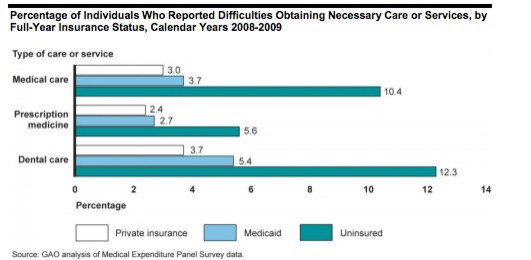Medicaid Patients, Privately Insured Have Same Access To Health Care

The Government Accountability Office recently conducted a comprehensive analysis of the Medicaid program and emerged with a conclusion that may not be taken well by proponents of private industry in the health care sector: The government program offers practically the same quality of medical care to beneficiaries as private insurance companies.
Since 2008, efforts by states to improve the low-income safety net program have resulted in lower application processing times and beneficiary coverage satisfaction comparable to private health insurance. The tightened efficiency -- the GAO reports states made numerous changes such as simplifying administrative requirements, expanding beneficiary services and increasing provider payments -- is likely the result of provisions implemented through the Children’s Health Insurance Program Reauthorization Act and the Affordable Care Act.
Here are the main takeaways from the report:
- There’s actually a sizable gap in dental care, with 5.4 of Medicaid beneficiaries reporting difficulty in obtaining those services compared to 3.7 percent of those with private insurance coverage. But that could because many state Medicaid programs don’t offer dental coverage. In fact, the subsidized health insurance plans that will be offered in 2014 under the Affordable Care Act -- now known as Obamacare -- are required to offer dental services to children, but not adults.
- Medicaid patients reported no more challenges in finding doctors than their private insurance counterpart when it came to medical care and prescription coverage.
- But it’s not all good news for Medicaid. While children on either public or private plans had virtually the same access to doctors, adults on Medicaid experienced more problems than those with private insurance coverage.
“About 7.8 percent of working-age adults with full-year Medicaid reported difficulty obtaining care compared with 3.3 percent of similar adults with private insurance -- a statistically significant difference,” states the report, noting it could be connected to the lower payments offered to physicians.
Still, it’s important to realize that Medicaid covers about 1 in every 3 children, making it the largest source of health insurance for children in the nation.
- The report looked into what keeps people from making it to the doctor. It turns out the biggest factor is not difficulty in scheduling an appointment or excessive wait times -- arguments often cited by opponents of government health care systems -- but a lack of transportation.
Under the 2011 federal poverty guidelines, a family of four must have a household income under $22,350 to qualify for Medicaid. It is safe to assume many of those families cannot afford their own mode of transportation.
The report did not delve into the quality differences between Medicaid and private insurance. But clearly, any health coverage is better than none at all, and the GAO findings show that far more people with Medicaid are able to obtain necessary healthcare services than the uninsured.
But the fact that Medicaid patients are reporting satisfaction with their coverage at almost the same rates as people with private health coverage -- at least in states where the program is well-funded -- suggests the program is far from the “health care gulag” it was described as by Sen. John Cornyn, Republican of Texas.
However, Republican governors across the nation continue to reject the Medicaid expansion offered by the Affordable Care Act. The 2010 law’s health care expansion heavily depends on an expansion of the joint federal-state program and would provide coverage for an additional 17 million uninsured people if every state participated.
At least a half-dozen governors continue to reject the program, even though it would be largely funded by the federal government. Most of those states are in the South, ranging from Florida to Texas -- coincidentally, the region with the lowest rate of health insurance coverage in the country.
© Copyright IBTimes 2024. All rights reserved.





















